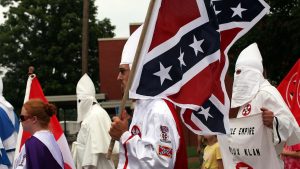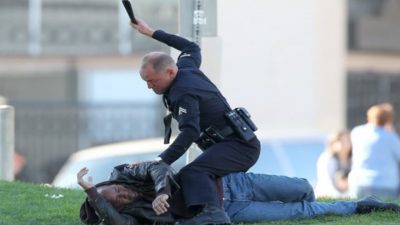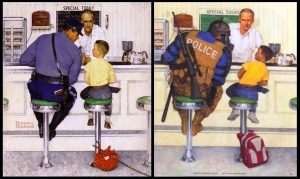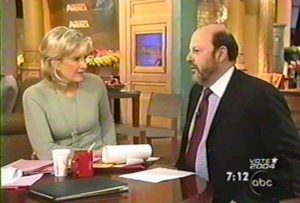![Police Misconduct Attorney]() CALIFORNIA CIVIL RIGHTS ATTORNEY CIVIL RIGHTS AND THE RISE OF THE POLICE STATE . . . . AS A PRACTICAL MATTER, WE LIVE IN A QUASI-POLICE STATE
CALIFORNIA CIVIL RIGHTS ATTORNEY CIVIL RIGHTS AND THE RISE OF THE POLICE STATE . . . . AS A PRACTICAL MATTER, WE LIVE IN A QUASI-POLICE STATE
Jerry L. Steering arguing before the Ninth Circuit Court of Appeals in police shooting case, Pasadena, California
If you think, as a practical matter, that you live in a “free country”, you’re wrong. We don’t. We live in a quasi-police state; at least to a very appreciable degree; too appreciable.
The National Security Agency spies on all Americans. They record all of our phone calls (cell or landline), our faxes, our emails, every key stroke of any online activities, and so much more. When these facts became public in the Spring of 2013, many people grumbled, but the grumbling only lasted for a few weeks. The unconstitutionality, and criminality of these actions of our “Big Brother“ (the National Security Agency) at least the last few Presidential administrations is apparent.
These “interceptions” constitute a search, that, pass muster under the Fourth Amendment to the Constitution, must be obtained pursuant to a search warrant; supported by probable cause. That means that the government must already have sufficient evidence that you are engaged in criminal activity before they get permission from a Judge to intercept your communications.
Under the guise of making us safe, the government has, and is, trampling the very pillars of liberty that millions have been wounded and have died to protect. In this respect, the terrorists have already won. They have made us more like them. They have caused us to abandon those principles of a free society, and has turned us into a police state. Do you feel safer knowing that there are secret courts, with secret judges, secret proceedings, that no one can check, examine or challenge?
THE POLICE STATE; THE POLICE USE THE COURT’S TO TRAMPLE YOUR LIBERTY BECAUSE THEY CAN.

We also are now in a “police state”, because, as a practical matter, the police can do just about whatever they want to you, and then procure the institution of a bogus criminal case against you, to protect themselves. They typically author bogus police reports that claim that you committed some crime, like resisting / obstructing / delaying a peace officer and/or battery on a peace officer, that result in a bogus criminal prosecution against you. Most of the time, they twist things around (i.e. the suspect struck my fist with his jaw.) There are a base collection of police report buzz words, that cops use to tickle the ambitious fantasies of young Deputy District Attorneys, who want to make a mark for themselves in the District Attorney’s Office, by persecuting the innocent, the actual victim, to protect the government from civil liability and obloquy. Some of these key terms are: 1) the suspect took an aggressive stance (or a fighting stance); 2) believing the suspect was going to strike me, I applied a departmental approved control hold, which the suspect, with his great strength, pulled out of; 3) I shot the suspect several times with my department issued taser, but it had no effect on the him; 4) I sprayed the suspect several times with my department issued pepper-spray, but it had no effect on the him; 5) I assisted the suspect to the ground by gently pushing the back of his knee with mine; 6) I tried to grab the suspect, but he pulled away from my grasp, and we both ended-up going to the ground, with me somehow landing on top of him; 7) I pointed my pistol directly at the suspect’s head and ordered him to show me his hands, but he refused to do so, and kept his hands in his waistband area, so I shot him (for LASD, 100%; (15) unarmed people were killed by LASD in 2010 with the waistband excuse); 8) I asked the suspect his name, and he said “fuck you motherfucker”; 9) the suspect continued to fight us (while we were both on-top of his back, holding both of his arms, with the suspect face down; some “fight”.) They go on and on.
The police know that the District Attorney’s Office takes great pride in protecting the police from civil liability, by filing and prosecuting criminal action. They do this to beat you down; to make it so expensive for you to defend yourself on bogus criminal charges, such as resisting arrest, that you take a plea bargain, and, in effect, bar a lawsuit by you for either false arrest, malicious prosecution, and, in most such cases, unreasonable force. They also do this to protect themselves from internal discipline and criminal liability for civil rights violations (18 U.S.C.§ 242.) The employing police agency will (almost) always deny that their officer engaged in wrongful conduct, especially in swearing contest type cases, where there is no video recording of the police beatings.
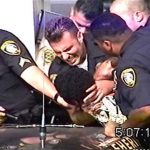 Because the employing police agency will (almost) always back their officers by touting their (false) version of the story in order to avoid civil liability to the employing entity for the actions of their officers, it’s almost impossible to discipline them. For example, the City of Inglewood, California, fired Inglewood Police Department officer Jeremy Morse, for the video recorded beating of a teenager at a gas station. When it came time for the civil suit against the City and the officers for the beating, the City contended that the officers acted properly. Accordingly, since the City took that position, fired officer Jeremy Morse sued the city, and won $1,600,000.00 for his wrongful firing.
Because the employing police agency will (almost) always back their officers by touting their (false) version of the story in order to avoid civil liability to the employing entity for the actions of their officers, it’s almost impossible to discipline them. For example, the City of Inglewood, California, fired Inglewood Police Department officer Jeremy Morse, for the video recorded beating of a teenager at a gas station. When it came time for the civil suit against the City and the officers for the beating, the City contended that the officers acted properly. Accordingly, since the City took that position, fired officer Jeremy Morse sued the city, and won $1,600,000.00 for his wrongful firing.
In 2010 the LA County Sheriff’s Department shot to death 15 people, who they claimed were reaching for their waistband; notwithstanding that none of the shooting victims were armed. No one was prosecuted or disciplined. Who needs a hunting license? Join the LA Sheriff’s Department, and you can shoot who ever you want to (unless the shooting is video recorded. If it is, the politicians may have to get rid of the officer.) Recently (forced to retire) LASD Undersheriff, Paul Tanaka, was a member of the Vikings; a White supremacist Neo-Nazi organization within the LA Sheriff’s Department. See, Thomas v. County of LA,978F.2d 504 (9th Cir. 1992.)
More recently, 18 LA County Deputies Sheriffs and Supervisors were Indicted by federal authorities on various charges of beating jail inmates and visitors without justification, unjustly detained people and conspired to obstruct a federal investigation into misconduct at the Men’s Central Jail. Sheriff Lee Baca has since retired from the scandal.
Lee Baca resigned from office over a scandal at the LA County Men’s Central Jail involving the Indictment of 18 LASD Deputy Sheriffs and their Supervisors for torturing prisoners and obstructing the FBI’s investigation of the same.
 On February 10, 2016, Sheriff Baca was convicted of 18 U.S.C. § 1001(a)(2); lying to the FBI regarding his knowledge of a scheme in the Sheriff’s Department to intimidate an FBI agent who was investigating complaints of beatings of inmates by deputies at the LA County Jail, and to hide an FBI informant – jail inmate from his FBI handlers.
On February 10, 2016, Sheriff Baca was convicted of 18 U.S.C. § 1001(a)(2); lying to the FBI regarding his knowledge of a scheme in the Sheriff’s Department to intimidate an FBI agent who was investigating complaints of beatings of inmates by deputies at the LA County Jail, and to hide an FBI informant – jail inmate from his FBI handlers.
Former Undersheriff Paul Tanaka, along with a retired LASD Captain, were indicted on May 13, 2015 by a federal Grand Jury for Obstructing and Conspiring to Obstruct a federal Grand Jury investigation of the rampant torturing of inmates at the LA County Jail (See, Paul Tanaka Indictment of May 13, 2015.)
That’s not the end of it. Former LASD Deputy Sheriff Noel Womack pleaded guilty in June of 2015 to federal charges of lying to the FBI about systemic LASD torturing and framing of inmates at the LA County Jails. In 2014, six LASD Deputy Sheriffs were convicted of obstructing the FBI’s investigation of the torturing of prisoners at the LA County Jails.
Thereafter, on April 6, 2016, former LASD Undersheriff was convicted by a jury of violation of 18 U.S.C. § 371
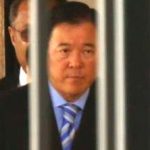 (conspiring to obstruct justice) and 18 U.S.C. § 1503(a) (obstructing justice), for not only obstructing an FBI investigation into years of beatings and torturing of inmates at the L.A. County Jail, but also Tanaka and other high ranking Sheriff’s Department officials threatening one of the FBI agents involved in that investigation, with arrest for continuing that investigation. In his trial, Tanaka admitted that he still had the Minnesota Vikings Logo tattoo on his leg; a tattoo that he described as a member in a club; the “Vikings”; a tatoo that the federal courts have held is the gang taoo for a “neo-Nazi white supremacists gang within the LA County Sheriff’s Department. See, Thomas v. County of LA, 978 F.2d 504 (1992).
(conspiring to obstruct justice) and 18 U.S.C. § 1503(a) (obstructing justice), for not only obstructing an FBI investigation into years of beatings and torturing of inmates at the L.A. County Jail, but also Tanaka and other high ranking Sheriff’s Department officials threatening one of the FBI agents involved in that investigation, with arrest for continuing that investigation. In his trial, Tanaka admitted that he still had the Minnesota Vikings Logo tattoo on his leg; a tattoo that he described as a member in a club; the “Vikings”; a tatoo that the federal courts have held is the gang taoo for a “neo-Nazi white supremacists gang within the LA County Sheriff’s Department. See, Thomas v. County of LA, 978 F.2d 504 (1992).
It should be noted that this article is not a condemnation of District Attorneys who don’t bring criminal charges against peace officers who commit homicides in the course of their official police duties. The author understands that it is extremely difficult to criminally convict California peace officers for duty related actions, such as shooting another, and that those District Attorney’s may not feel that a criminal prosecution would actually be successful; notwithstanding any personal belief of the criminality of those actions by the District Attorneys of California.
THE RISE OF THE POLICE STATE: CONTEMPT OF COP CASES “RESISTANCE OFFENSE” CASES.
Perhaps the greatest threat to the right to be left alone by the government, is the abuse of certain criminal statutes to stifle verbal challenge or protest of police actions and statements. In the real world, if you “fail the attitude test“, you’re just committed “Contempt of Cop“; a phrase that unfortunately represents the trigger for most arrests of innocents for certain crimes against peace officers. “Contempt Of Cop“ cases, are bogus criminal actions, brought against innocents by criminal prosecutors, for essentially, “bruised ego“ violations. The “ego bruising”, is really nothing more than a civilian not immediately, and without protest or question, getting-down on the ground in a proned position, or not doing something that the officer wants you to do (lawful, reasonable or not) immediately, and without question or protest.
The Constable‘s “ego” is typically “bruised”, by your conduct, such as: 1) asserting your Constitutional rights, or 2) claiming knowledge of them, or 3) asking the Constable why you’re being ordered to lie down on the ground while your chest is being illuminated by the red spot of a pistol or rifle targeting device; 4) telling the Constable that you have a medical condition that makes it difficult or painful to get on the ground; 5) telling the Constable that he can’t do something (i.e. can’t go in my house without a warrant; you can’t make me go inside or come outside); 6) failing to consent to an entry or a search; and 7) not exiting your house when ordered to do so (even though the police generally can’t order you to exit a private residence; save probable cause to arrest for serious dangerous felony, coupled with an emergency; See, United States v. Al-Azzawy, 784 F.2d 890 (9th Cir. 1985) and Elder v. Holloway, 510 U.S. 510 (1994.)) These are but a few examples. The list is endless, but the theme is the same. Failing to immediately do whatever the police tell you to do, without protest, disapproval, challenge or remarks, often will result in your being beaten-up, falsely arrested, and maliciously criminally prosecuted.
These, “Contempt Of Cop“ cases also typically involve the police using force upon persons (i.e. beating them) and/or falsely arresting them, and then inventing bogus allegations of violations various “Contempt Of Cop“ statutes, such as violations of: 1) Cal. Penal Code § 148(a)(1) (resisting / obstructing / delaying peace officer [commonly called “resisting arrest”]; the most abused statute in the Penal Code; 2) Cal. Penal Code § 240/241(b) (assault on a peace officer); 3) Cal. Penal Code § 242 / 243(b) (battery on a peace officer); and 4) Cal. Penal Code § 69 (interfering with public officer via actual or threatened use of force or violence.) Cal. Penal Code § 69 is a “wobbler”; a California public offense that may be filed by the District Attorney’s Office as either a felony or a misdemeanor. In Orange County, Riverside County and LA County, allegations of violation ofPenal Code § 69 are usually filed as misdemeanors. In San Bernardino County, however, allegations of violation of Cal. Penal Code § 69 are filed as felonies much more often than her sister counties. If they shoot you, they may even charge you with Cal. Penal § Code 245(d); assault on a peace officer in a manner likely to result in great bodily injury.
Cal. Penal Code § 148(a)(1) (resisting / obstructing / delaying peace officer) is the most abused statute in the Penal Code, because of it’s inherent ambiguity. It is so vague, that almost any interaction, or failure to interact, with the police,can be “tailored” to apply to non-criminal conduct. What exactly does it mean to “resist” or to “obstruct” or to “delay” a peace officer in the lawful performance of their duties? No one knows. There is no meaning. It means everything, and it means nothing.
Mr. Steering is an expert in “Contempt Of Cop” type cases, and has litigated, consulted, advised or has otherwise been involved in thousands of these type of bogus criminal cases; usually for fabricated charges of either: 1) resisting / obstructing / delaying a peace officer in the lawful performance of his duties, 2) assault and battery on a peace officer, 3) using / threatening use of force or violence to deter or prevent a public officer from performing their duty, 4) assault with a deadly weapon on a peace officer, or, 5) attempted murder of a peace officer.
Unfortunately, the natural American reaction to hearing that you are accused of a crime, is to presume that you actually committed some crime, or otherwise acted unlawfully, anti-socially dishonorably or despicably. These, “Contempt Of Cop“ cases, typical involve the police using force upon persons (i.e. beating them) and/or falsely arresting them, and then inventing bogus allegations of violations various “Contempt Of Cop” statutes, such as violations of: 1) Cal. Penal Code § 148(a)(1) (resisting / obstructing / delaying peace officer; the most abused statute in the Penal Code; 2) Cal. Penal Code § 240/241(b)(assault on a peace officer); 3) Cal. Penal Code § 242 / 243(b) (battery on a peace officer); and 4) Cal. Penal Code § 69 (interfering with public officer via actual or threatened use of force or violence.) Cal. Penal Code § 69 is a “wobbler”; a California public offense that may be filed by the District Attorney’s Office as either a felony or a misdemeanor. In Orange County, Riverside County and LA County, allegations of violation of Penal Code § 69 are usually filed as misdemeanors. In SB County, however, allegations of violation of Cal. Penal Code § 69 are filed as felonies much more often than her sister counties.
THE RISE OF THE POLICE STATE; THE UNINTENDED CONSEQUENCES OF THE EXCLUSIONARY RULE.
WHAT IS THE EXCLUSIONARY RULE?
The “Exclusionary Rule” prevents the government from using most evidence in criminal cases that was obtained in violation of the United States Constitution. It applies to evidence gained from an unreasonable search or seizure in violation of the Fourth Amendment, see Mapp v. Ohio, 367 U.S. 643 (1961), to improperly elicited self-incriminatory statements gathered in violation of the Fifth Amendment, See, Miranda v. Arizona, 384 U.S. 439 (1966), and to evidence gained in situations where the government violated defendants Sixth Amendment Right to Counsel, See, Miranda. The rule does not apply to civil cases, including deportation hearings. See, INS v. Lopez-Mendoza, 468 U.S. 1032 (1984.)
If evidence that falls within the scope of the exclusionary rule led law enforcement to other evidence, which they would not otherwise have located, then the exclusionary rule applies to the related evidence found subsequent to the excluded evidence as well. Such subsequent evidence has taken on the name of fruit of the poisonous tree.
The Exclusionary Rule is a court-created remedy and deterrent, not an independent constitutional right. Courts will not apply the rule to exclude illegally gathered evidence where the costs of exclusion outweigh its deterrent or remedial benefits. Thus, the rule is not triggered when courthouse errors lead police officers to mistakenly believe that they have a valid search warrant, because excluding the evidence would not deter police officers from violating the law in the future. See, Arizona v. Evans, 541 U.S. 1 (1995.)
WHY DID THE EXCLUSIONARY RULE DISMANTLE MANY OF OUR CONSTITUTIONAL PROTECTIONS.
People who believe the Courts are a bunch of judges who let the criminals go free for the slightest technicality, have no concept of reality. In fact, most people don’t have a clue as to what Constitutional rights they have, or, in many situations, what Constitutional rights they used to have. For example, most people believe that when the police arrest you, that they are somehow obligated to read you your Miranda warnings. They aren’t, and they usually don’t.; especially when the witnessed or participated in the event that they are calling a crime. All that Miranda v. Arizona, 384 U.S. 436 (1966) stands for, is the proposition that after you’re in police custody (i.e. arrested), that any statement that you make to the police in response to custodial police interrogation, cannot be introduced into evidence against you at your criminal trial, unless you were first advised of your right to counsel (under the Sixth Amendment to the United States Constitution) and your right against self-incrimination (under the Fifth Amendment to the United States Constitution.) However, if you take the witness stand and testify at your criminal trial, statements made by you that were obtained in violation of Miranda can then be introduced against you, because the exclusionary rule is not a license to lie
In Federal and in California criminal cases (and, in reality, every other appellate court in the United States), the Appellate Courts very often distort and pervert the contours the protections provided to us in the United States Constitution, by simply stating that the Constitution doesn’t prohibit a particular form of government conduct. They do this so they don’t have to exclude evidence in a criminal trial; evidence that will often prove the defendant’s guilt, and without which, the government had no case. This, unfortunately, is the unintended consequence of the exclusionary rule; the rule created by the United States Supreme Court, to curb unlawful police conduct that results in the police illegally obtaining evidence, in Weeks v. United States 245 U.S. 618 (1918) (exclusion of illegally obtained evidence in federal court criminal trials) and Mapp v. Ohio, 367 U.S. 643 (1961) (exclusion of illegally obtained evidence in state court criminal trials.) When Judges are faced with a choice of either excluding incriminating evidence at criminal trial because it was obtained in violation of the Federal Constitution, or simply re-characterizing and deliberately misinterpreting what the contours of those protections are, many many times, the Courts will choose perverting our Constitutional protections. In other words, Appellate Court Judges often “change” (by judicial fiat)the protections of the Constitutional provision at issue, to let the evidence in. Although this may be just wonderful for convicting the guilty, the consequences of reducing the protections afforded to all persons under a particular Constitutional provision undermines the liberty interests of the rest of us innocent people:
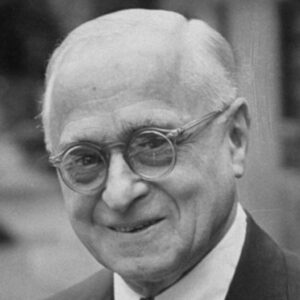 “By the Bill of Rights the founders of this country subordinated police action to legal restraints, not in order to convenience the guilty but to protect the innocent. Nor did they provide that only the innocent may appeal to these safeguards. They knew too well that the successful prosecution of the guilty does not require jeopardy to the innocent. The knock at the door under the guise of a warrant of arrest for a venial or spurious offense was not unknown to them. Compare the statement in Weeks v. United States, 232 U.S. 383, 390, 34 S.Ct. 341, 343, that searches and seizures had been made under general warrants in England ‘in support of charges, real or imaginary.’ We have had grim reminders in our day of their experience. Arrest under a warrant for a minor or a trumped-up charge has been familiar practice in the past, is a commonplace in the police state of today, and too well-known in this country. See Lanzetta v. New Jersey, 306 U.S. 451, 59 S.Ct. 618, 83 L.Ed. 888. The progress is too easy from police action unscrutinized by judicial authorization to the police state. The founders wrote into the Constitution their conviction that law enforcement does not require the easy but dangerous way of letting the police determine when search is called for without prior authorization by a magistrate. They have been vindicated in that conviction. It may safely be asserted that crime is most effectively brought to book when the principles underlying the constitutional restraints upon police action are most scrupulously observed.” United States v. Rabinowitz, 339 U.S. 56 (1950); Frankfurter, J.
“By the Bill of Rights the founders of this country subordinated police action to legal restraints, not in order to convenience the guilty but to protect the innocent. Nor did they provide that only the innocent may appeal to these safeguards. They knew too well that the successful prosecution of the guilty does not require jeopardy to the innocent. The knock at the door under the guise of a warrant of arrest for a venial or spurious offense was not unknown to them. Compare the statement in Weeks v. United States, 232 U.S. 383, 390, 34 S.Ct. 341, 343, that searches and seizures had been made under general warrants in England ‘in support of charges, real or imaginary.’ We have had grim reminders in our day of their experience. Arrest under a warrant for a minor or a trumped-up charge has been familiar practice in the past, is a commonplace in the police state of today, and too well-known in this country. See Lanzetta v. New Jersey, 306 U.S. 451, 59 S.Ct. 618, 83 L.Ed. 888. The progress is too easy from police action unscrutinized by judicial authorization to the police state. The founders wrote into the Constitution their conviction that law enforcement does not require the easy but dangerous way of letting the police determine when search is called for without prior authorization by a magistrate. They have been vindicated in that conviction. It may safely be asserted that crime is most effectively brought to book when the principles underlying the constitutional restraints upon police action are most scrupulously observed.” United States v. Rabinowitz, 339 U.S. 56 (1950); Frankfurter, J.
YOUR REMEDIES FOR CIVIL RIGHTS VIOLATIONS BY OFFICERS; “THE KU KLUX KLAN ACT OF 1871″; 42 U.S.C. § 1983.
The federal statute that persons in the United States use every day to sue police officers and other persons acting under the color of law, is “The Ku Klux Klan Act of 1871″; 42 U.S.C. § 1983. That statute is the vehicle that is used today to sue police officers and other governmental officials. It’s literally the most used law in the United States to sue police officers for violating the federal Constitutional rights of another.
In the years after the Civil War, the South began to see the emergence of white terrorist groups. These organizations of composed mostly of veterans still aspring to the goals of the Confederacy and their own Southern heritage, brought terror to freed blacks who looked to participate in the community as well as to their white allies. The Ku Klux Klan Act of 1871 was Congress’ attempt to put an end to the policies of terrorism, intimidation, and violence that the Klan, the Knights of the White Camelia, and the Jayhawkers had been using. The law unfortunately failed to eradicate the Klan or abolish the continued use of fear tactics and brutality against blacks and supportive whites.
Founded as a fraternal organization by Confederate veterans in Pulaski, Tennessee, in 1866, the Ku Klux Klan soon became a paramilitary group devoted to the overthrow of Republican governments in the South and the reassertion of white supremacy. Through murder, kidnapping, and violent intimidation, Klansmen sought to secure Democratic victories in elections by attacking black voters and, less frequently, white Republican leaders.
In response to Klan violence, Congress passed the first of three Enforcement Acts on May 31, 1870, to ensure that the provisions of the Fourteenth and Fifteenth Amendments were followed. The act, which made it a federal offensive to try to deprive anyone of his civil rights, had little effect on the deteriorating situation. A second Enforcement Act, passed on February 28, 1871, established federal supervision over elections, but also did little to remedy the situation. After the failure in the House of a more powerful bill that would have given the federal government additional power to enforce election law, President Grant decided to intervene. The President met with Congressional leaders to urge the passage of stronger legislation, and on their recommendation, Grant issued a direct appeal to Congress requesting a new law. Grant’s appeal was successful, and Congress passed the Ku Klux Klan Act.
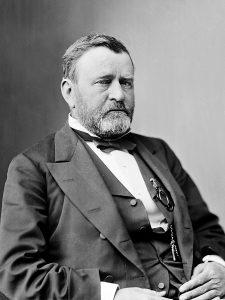
ON APRIL 20, 1971, CONGRESS PASSED THE KU KLUX KLAN ACT; THE THIRD ENFORCEMENT ACT TO ENFORCE THE 14TH AMENDMENT.
Also known as the Third Enforcement Act, the bill was a controversial expansion of federal authority, designed to give the federal government additional power to protect voters. The act established penalties in the form of fines and jail time for attempts to deprive citizens of equal protection under the laws and gave the President the authority to use federal troops and suspend the writ of habeas corpus in ensuring that civil rights were upheld.
President Grant put the new legislation to work after several Klan incident in May of 1871. He sent additional troops to the South and suspended the writ of habeas corpus in nine counties in South Carolina. Aided by Attorney General Amos T. Akermen and the newly created Department of Justice, extensive work was done to prosecute the Klan. While relatively few convictions were obtained, the new legislation helped to suppress Klan activities and ensure a greater degree of fairness in the election of 1872.
In 1871 Congress enacted the Ku Klux Klan Act (42 U.S.C. § 1983), that gives any person whose federal Constitutional rights have been violated, a right to sue, any person who violated those rights under the color of state law, in a United States District Court. Section 1983 lawsuits can also be brought in a state court of general jurisdiction; See, 42 U.S.C. § 1988. Accordingly, a person who is falsely arrested by a peace officer (i.e. police officer, deputy sheriff, or some other officer who derives peace officer powers from state law), may sue the police officer under Section 1983, as well as under California state law. Similarly, one who is subjected to unreasonable force, a malicious criminal prosecution, or other Constitution violation, may sue in a federal or state court for redress under Section 1983.
Commonly referred to as “Section 1983 cases or actions, this federal statute was enacted by Congress in response to a letter from President Ulysses S. Grant; complaining of the conditions in the Southern states, and asking Congress to create a remedy for persons of African descent (i.e. former slaves), for violation of their federal Constitutional rights, by persons acting under the color of state law; the Sheriff and his posse. That’s what the KKK did. The local Sheriff and his posse, deputized and KKK members, would murder former slaves, but their widows and children had no actual remedy in Southern state courts; no remedy that either a Court would allow to proceed, or if so allowed, that a Southern white Post Civil War jury, would award compensation for. Accordingly, President Grant wanted persons of African descent to have a remedy in federal court, for such atrocities. Similar criminal statutes were enacted by Congress for the same Constitutional violations, in 18 U.S.C. § 241 in 1966 (conspiracy to violate Constitutional rights), and 18 U.S.C. § 242 in 1870 (violation of federal Constitutional rights under color of law.
If you have been the victim of Excessive Force or a False Arrest by a police officer, please check our Section, above, entitled: “What To Do If You Have Been Beaten-Up Or False Arrested By The Police“. Also, please click on “Home“, above, or the other pages shown, for the information or assistance that we can provide for you. If you need to speak with a lawyer about your particular legal situation, please call the Law Offices of Jerry L. Steering for a free consultation.
Click on “Home“, above, or the other pages shown, for the information or assistance that we can provide for you. If you need to speak with a lawyer about your particular legal situation, please call the Law Offices of Jerry L. Steering for a free telephone consultation.
Thank you, and best of luck, whatever your needs.
Law Offices of Jerry L. Steering
Jerry L. Steering, Esq.

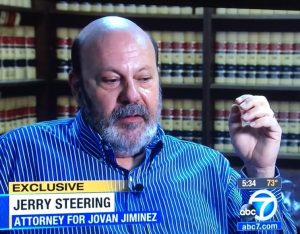 CALIFORNIA CIVIL RIGHTS ATTORNEY CIVIL RIGHTS AND THE RISE OF THE POLICE STATE . . . . AS A PRACTICAL MATTER, WE LIVE IN A QUASI-POLICE STATE
CALIFORNIA CIVIL RIGHTS ATTORNEY CIVIL RIGHTS AND THE RISE OF THE POLICE STATE . . . . AS A PRACTICAL MATTER, WE LIVE IN A QUASI-POLICE STATE